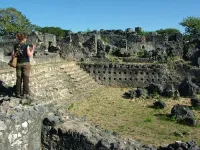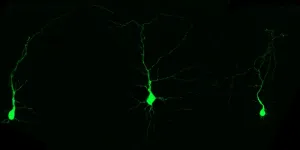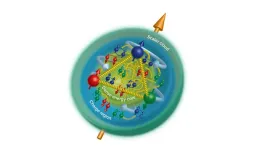(Press-News.org) A team of researchers from Ohio University’s Heritage College of Osteopathic Medicine recently discovered a novel role of human-CIDEC gene in improving metabolic dysfunction and cardiovascular health. The study, “Endothelial-Specific Expression of CIDEC Improves High-Fat Diet–Induced Vascular and Metabolic Dysfunction,” published in Diabetes focuses on vascular function and its association with metabolic diseases like insulin resistance, Type 2 diabetes, and cardiovascular disease.
“This is a very impactful study, and we have moved in the right direction to find a way to reduce cardiovascular diseases,” said Vishwajeet Puri, Ph.D., professor of biomedical sciences and co-director of the Diabetes Institute. He was the principal investigator and senior author of the study. “When looking at diseases like diabetes and obesity, you cannot disassociate them from cardiovascular disease since they are all closely associated. Discoveries like this one allow us to not only manage the disease but work to cure it and help fight any related disorders.”
According to Bijinu Balakrishnan, Ph.D., a scientist in Puri’s lab who led the study, endothelial cells line the blood vessels and play a major role in maintaining vascular function including blood pressure. He explains that endothelial dysfunction has a major role in the progression of insulin resistance, diabetes, cardiovascular disease and other metabolic diseases.
“We recently discovered that CIDEC, previously identified as fat-associated protein in adipocytes, is abundantly expressed in endothelial cells and regulates its function,” Balakrishnan said. “The objective of the study was to find the mechanism of action of how human-CIDEC regulates the endothelial function and to determine its effect on whole-body physiology.”
To conduct the study, the team of researchers generated humanized transgenic mice that expressed human CIDEC transgene, specifically in endothelial cells. Using mice as the model was instrumental in determining the cardiometabolic effects of the human-CIDEC gene and its role in protection against obesity-induced metabolic dysfunctions. To mimic the obese state in humans, the mice were fed a high-fat diet.
“These humanized transgenic mice showed protection against high-fat diet-induced insulin resistance and displayed lower circulating lipid levels,” Balakrishnan said.
“It’s amazing to see that an endothelial-specific expression of a human transgene in mice could protect them from obesity-associated metabolic disorders,” Puri added.
Their findings contribute to the understanding of the role of the vascular endothelium in regulating systemic metabolism and prompt recognition for potentially targeting the vasculature for the treatment of obesity-associated cardiometabolic disorders.
“Cardiovascular diseases are the leading cause of death worldwide and have a significant negative influence on patient quality of life and disability,” Balakrishnan said. “Endothelial dysfunction contributes significantly to the development and progression of cardiovascular pathophysiology and is considered an early predictor of cardiovascular events.”
In addition to Puri and Balakrishnan, members of the research team from Ohio University’s Heritage College also include Abhishek Gupta, Vishva M. Sharma, Mark Slayton, Rabia Basri, Kailey Gentner, Chloe Becker, Harrison Muturi, and Endowed Eminent Research Chair Sonia M. Najjar. The team also collaborated with researchers Shakun Karki, and Noyan Gokce, from Boston University School of Medicine, and Analia S Loria, from the University of Kentucky in Lexington. The study was funded by the National Heart, Lung, and Blood Institute.
“This study truly shows the power of teamwork and collaboration,” Puri said. “It is thrilling to see the diversity of people contributing to advance science and medicine. We have researchers on this study with diverse ethnic backgrounds, with all sorts of experience levels ranging from established scientists to undergraduate students, and with all types of areas of expertise such as cardiologists, cell biologists, physiologists and more.”
Originally from India, Balakrishnan came to OHIO to study molecular mechanisms associated with cardiovascular disease. Prior to his time at OHIO, Balakrishnan received his Ph.D. from Myongji University in the Republic of Korea in 2012 where his primary focus was to elucidate the biosynthetic pathway of fungal polyketides. While pursuing his doctoral degree, he published nine papers and found a position at the Mayo Clinic to pursue his postdoctoral training to study the role of pancreatic lipases in acute pancreatitis. He became interested in obesity-associated metabolic diseases, including cardiovascular disease and in 2018 joined Puri’s laboratory. During his first year of post-doctoral training in Puri’s lab, he received the American Heart Association Postdoctoral Fellowship award for two years to work on identifying the role of CIDEC protein in vascular functions.
Puri is the Osteopathic Heritage Foundation Ralph S. Licklider, D.O., Endowed Professor in Diabetes at the Heritage College. He is recognized for identifying the CIDE proteins and their role in pathogenesis and pathophysiology of obesity, type 2 diabetes and cardiovascular disease.
END
OHIO diabetes researchers discover the potential of CIDEC protein to mitigate obesity-related cardiometabolic disease
2023-03-29
ELSE PRESS RELEASES FROM THIS DATE:
The COVID-19 pandemic has increased – but also polarised – trust in science
2023-03-29
Research by the Milner Centre for Evolution at the University of Bath, UK, along with colleagues at Universities of Oxford and Aberdeen, finds that trust in scientists has hugely increased overall since the COVID-19 pandemic, but that attitudes have also become more polarized. The study also found that people were more likely to take the COVID-19 vaccine if their trust in the science had increased.
Whether it be climate change, vaccines or GM foods, trust in science and scientists has rarely been more important. ...
DoD funds new project aimed at protecting global supply chains, infrastructure
2023-03-29
Thanks to the work of Arizona Sen. Mark Kelly, a new project led by Northern Arizona University, with various collaborators throughout the nation, will help the United States better protect the critical supply chain infrastructure and the supply chains that keeps the country and its economy running.
Benjamin Ruddell, professor in the School of Informatics, Computing, and Cyber Systems and founder of the FEWSION project, is the NAU lead. Funded at $8 million for year one, the project aims to work with technology known as Fused Global Data Analytics and Visualization. The team’s leadership, ...
CNIO researchers help to understand the functioning of the protein that makes DNA loops in the human genome
2023-03-29
Cohesin is a ring-shaped protein that surrounds and moves around the DNA molecule, forming the loops. It is a crucial process for the cell.
Understanding how cohesin works has been one of the challenges of molecular biology in recent decades.
The work now published by Ana Losada's group at CNIO will serve to deepen our understanding of the disease known as Cornelia de Lange syndrome.
At the end of the 1990s, Ana Losada, a researcher at the Spanish National Cancer Research Centre (CNIO), then at the Cold Spring Harbor Laboratory (New York, USA), discovered a protein in frogs of the Xenopus genus that is fundamental to ...
AI could set a new bar for designing hurricane-resistant buildings
2023-03-29
Being able to withstand hurricane-force winds is the key to a long life for many buildings on the Eastern Seaboard and Gulf Coast of the U.S. Determining the right level of winds to design for is tricky business, but support from artificial intelligence may offer a simple solution.
Equipped with 100 years of hurricane data and modern AI techniques, researchers at the National Institute of Standards and Technology (NIST) have devised a new method of digitally simulating hurricanes. The results of a study published today in Artificial Intelligence for the Earth Systems demonstrate that the simulations can accurately ...
Caesarean Scar Disorder: International study led by Amsterdam UMC defines a clinical condition
2023-03-29
More than 30% of women who give birth by caesarean section suffer from long-term symptoms, such as abdominal pain, blood loss or fertility problems. These symptoms are caused by an abnormal uterine scar. This condition is defined now for the first time, thanks to an international study led by Amsterdam UMC, as Caesarean Scar Disorder (CSDi). This gives women recognition for these problems after a caesarean section. In addition, international studies on CSDi can now be better compared with each other, providing more insight into treatment options. The research is published today in JAMA Network Open.
In ...
Ancient DNA reveals African and Asian ancestry of medieval Swahili people
2023-03-29
People living on the ‘Swahili coast’ - the Indian Ocean coast of eastern Africa - have African and Asian ancestry according to new research on ancient DNA.
Archaeologists believe that the results, based on finds from excavations, including those directed by Professor Stephanie Wynne-Jones from the University of York and Professor Jeffrey Fleisher at Rice University, confirm that relationships between Asian merchants and African traders were formed between the years 900 and 1100 in ...
Feed them or lose them
2023-03-29
Brain development consists of a sequence of coordinated steps, which are mainly instructed by our genes. During these steps, the proper positioning and functionality of nerve cells in the brain (neurons) are critical—nonfunctional or incorrectly positioned neurons can lead to severe neuropathological consequences. Mutations in genes coordinating this program are often linked to neurodevelopmental disorders; however, environmental stressors such as nutrient scarcity or malnutrition can also influence the development of the brain. Still, very little is known about the importance of specific nutrients ...
Astronomers witness the birth of a very distant cluster of galaxies from the early Universe
2023-03-29
Using the Atacama Large Millimeter/submillimeter Array (ALMA), of which ESO is a partner, astronomers have discovered a large reservoir of hot gas in the still-forming galaxy cluster around the Spiderweb galaxy — the most distant detection of such hot gas yet. Galaxy clusters are some of the largest objects known in the Universe and this result, published today in Nature, further reveals just how early these structures begin to form.
Galaxy clusters, as the name suggests, host a large number of galaxies — sometimes even thousands. They also contain a vast “intracluster medium” (ICM) of ...
Ancient DNA reveals Asian ancestry introduced to East Africa in early modern times
2023-03-29
At a glance:
Who were the people of the medieval Swahili civilization? Ancient DNA reveals African founders intermingled with migrants from southwest Asia around 1000 CE
Findings complicate scientific views as well as colonial-era beliefs
For the first time, analyses determine that some present-day Kenyans who identify as Swahili are genetically very different from medieval residents of the same region, while others have retained substantial medieval ancestry
While serfs toiled and knights jousted in Europe and samurai and shoguns rose to power in Japan, the ...
Charming experiment finds gluon mass in the proton
2023-03-29
NEWPORT NEWS, VA – Nuclear physicists may have finally pinpointed where in the proton a large fraction of its mass resides. A recent experiment carried out at the U.S. Department of Energy’s Thomas Jefferson National Accelerator Facility has revealed the radius of the proton’s mass that is generated by the strong force as it glues together the proton’s building block quarks. The result was recently published in Nature.
One of the biggest mysteries of the proton is the origin of its mass. It turns out that the proton’s measured mass doesn’t just come from its physical building blocks, its three so-called valence quarks.
“If you add up the ...




